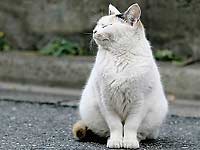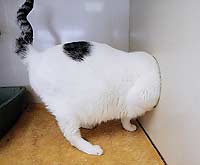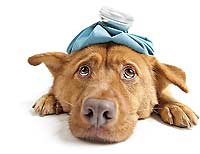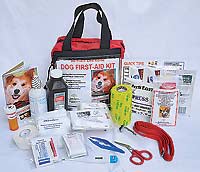Fat Cat Slimdown
by Jessica Turquette co-owner of the Moab BARKery |
If you’re owned by an overweight or obese cat, it can be especially difficult to get Mr. Chunky moving if he’s not of a mind to. Thankfully, there are lots of researchers, scientists, and educators out there who are trying to help pet parents learn how to keep their animals lean and fit, and have found a strategy of feedings and diet type that increase weight loss and help kitties maintain a healthy weight by using their natural instincts.
 University of Illinois researchers interested in helping kitties maintain a healthy body weight set out to test a previously suggested claim that increased meal frequency could help to increase overall physical activity. The goal of the study was to investigate how increasing meal frequency and dietary water content might influence voluntary physical activity in cats of normal body weight. University of Illinois researchers interested in helping kitties maintain a healthy body weight set out to test a previously suggested claim that increased meal frequency could help to increase overall physical activity. The goal of the study was to investigate how increasing meal frequency and dietary water content might influence voluntary physical activity in cats of normal body weight.
At the end of their two-part experiment, the U of I research team concluded that cats fed frequent small meals have increased physical activity during the two hour window preceding each mealtime. They also determined that cats fed a moisture-dense diet were even more active, and their activity levels peaked after meals – not before, so by combining multiple meals and then adding a moisture rich diet you can provide a metabolic double whammy!
During the second part of the experiment, which involved food with added water, the kitties showed an even greater increase in physical activity. Interestingly, peak activity times for this group were after mealtime rather than in anticipation of being fed. The researchers couldn’t determine why that would be, but theorized that increased use of litter boxes may have been a factor.
 Cats fed a diet of dry kibble live in a state of low-grade dehydration. Their bodies are water-starved, because dry cat food doesn’t provide nearly the moisture cats need from their food. As everyone knows, water is essential for the proper functioning of every organ and body system including the bowels. So cats fed a kibble diet used the box less often with a much larger and stinkier stool. An adequate level of moisture in their diet probably gave the cats more energy and a feeling of well-being that naturally increased their physical activity level and they were able to use more of the food they ate so their stool was less offensive and smaller, but more frequent. Cats fed a diet of dry kibble live in a state of low-grade dehydration. Their bodies are water-starved, because dry cat food doesn’t provide nearly the moisture cats need from their food. As everyone knows, water is essential for the proper functioning of every organ and body system including the bowels. So cats fed a kibble diet used the box less often with a much larger and stinkier stool. An adequate level of moisture in their diet probably gave the cats more energy and a feeling of well-being that naturally increased their physical activity level and they were able to use more of the food they ate so their stool was less offensive and smaller, but more frequent.
The plan is not perfect though; there is a factor of your cat! Yes your picky eater may not agree with the plan. We recommend introducing small amounts of wet food at meal time first as a treat and then as a larger part of the overall daily meal. My cats get fed two wet meals a day and 1 dry. It’s our compromise for those days when they just hate the wet option. Our wet options rotate between canned and raw food and our kibble is always premium grain free with low glycemic fillers such as garbanzo beans, lentils, peas and sweet potato. Make your plan and help your small carnivores’ metabolism thrive.
|
Fido First Aid Kit
by Jessica Turquette co-owner of the Moab BARKery |

It can be very unsettling and confusing for pet parents when a crisis with a beloved dog arises, which is why having an emergency first aid kit on hand is a great idea. That way, you have supplies available and right at your fingertips to care for your dog until you can get him either to your vet’s office or an emergency animal clinic.
It’s best to put all your first aid supplies in a metal or plastic container labeled with Pet First Aid. On the inside lid of the container, add a label listing your vet’s phone number, the number of the closest emergency animal clinic. This is also a good place to record any other pertinent information you might need in a hurry, like your dog’s license tag number, microchip registration number, date of last rabies vaccination, etc.
Keep your kit in an easily accessible location and let everyone in the family know where it is.
• Gauze to wrap wounds or for use as a muzzle if necessary
• Nonstick bandages or strips of clean cloth to cover a wound or control bleeding
• Adhesive tape like vet wrap to secure gauze, bandages or strips of cloth
• Clean towels (paper and cloth)
• Povidone iodine for wound disinfecting
• Activated charcoal to absorb an ingested poison (always contact vet before using)
• Hydrogen peroxide 3% to induce vomiting (after consulting with vet, some items need to come quickly but often if it’s been more than 2 hours since incident this method is not recommended)
• Digital rectal thermometer
• Eye dropper or large syringe without needle to give medicine or liquids or to flush wounds
• Muzzle (injured dogs can become aggressive out of fear or pain, however, if your dog is vomiting, do not muzzle him)
• Extra leash or harness
• Stretcher for large dogs (a blanket, throw rug, floor mat, board or other object can be used in a pinch)
• Basic guide or pocket reference for dog and cat first aid care. When you are panicked instructions can help!
Additional items that can be of big help but are not necessary for major problems:
• Tick removal tool
• Scissors
• nail clippers
• styptic powder/gel
• cotton balls
• eye wash/rinse
• ear cleanser
• antiseptic wipes
• Benadryl
• Disposable gloves
• Homeopathic Aconitum
for shock |

|
Dog Friendly Walks/Hikes in the Moab Area |
| Trail or Walk |
Difficulty |
Length
(one way) |
Proximity to Downtown |
MillCreek Pathway
|
easy |
1.1 miles |
Little to no driving
Starts at 100 S & 100 W |
Portal Overlook
(trailhead @ Jaycee Park) |
Hard |
2.0 miles |
25 min drive N on US-191 to W on Utah 279 (4.2 miles) |
| Moab Rim |
Hard |
3.0 miles
(to Hidden Valley trail) |
8 minute drive
2.6 miles down Kane Creek Blvd from US-191 |
Negro Bill Canyon
(aka William Grandstaff Canyon) |
Moderate |
2.0 miles |
10 minute drive N on US-191 to
W on Utah 128, 3 miles |
| Hunter Canyon |
Easy |
2.0 miles |
25 minute drive (mild off-road)
7.5 miles down Kane Creek Blvd from US-191 |
| Corona Arch Trail |
Easy/Moderate |
1.5 miles |
25 minute drive N on US-191 to
W Utah 279 (10 miles) |
Hidden Valley
(trailhead at end of Angel Rock Rd)
|
Hard |
2.0 miles |
10 minute drive
S on US-191
3 miles to Angel Rock Rd |
Fisher Towers
(trailhead 2.2 miles off Utah 128)
|
Moderate |
2.2 miles |
35 minute drive N on US-191 to Utah 128, then 21 miles |
Tips for enjoying your time with your dog here in the Moab area:
- Bring lots of extra water for you and your dog.1 gallon per day for every 60lbs of dog!!
- Don’t let dogs chase wildlife (especially coyotes, they can lead dogs into an ambush).
- In the city, dogs are required to be leashed, but on public lands off leash with voice control is allowed.
- Slickrock and sand is very abrasive! Check paw pads often, or buy and use booties.
- If it’s over 85 degrees only consider early AM or late PM hikes, daycare or leave your dog at home.
- Pack out my poop! Seriously or the other hikers without dogs will eventually demand no dogs allowed!
|
To see past articles about animals, pets and their care check our archives. |